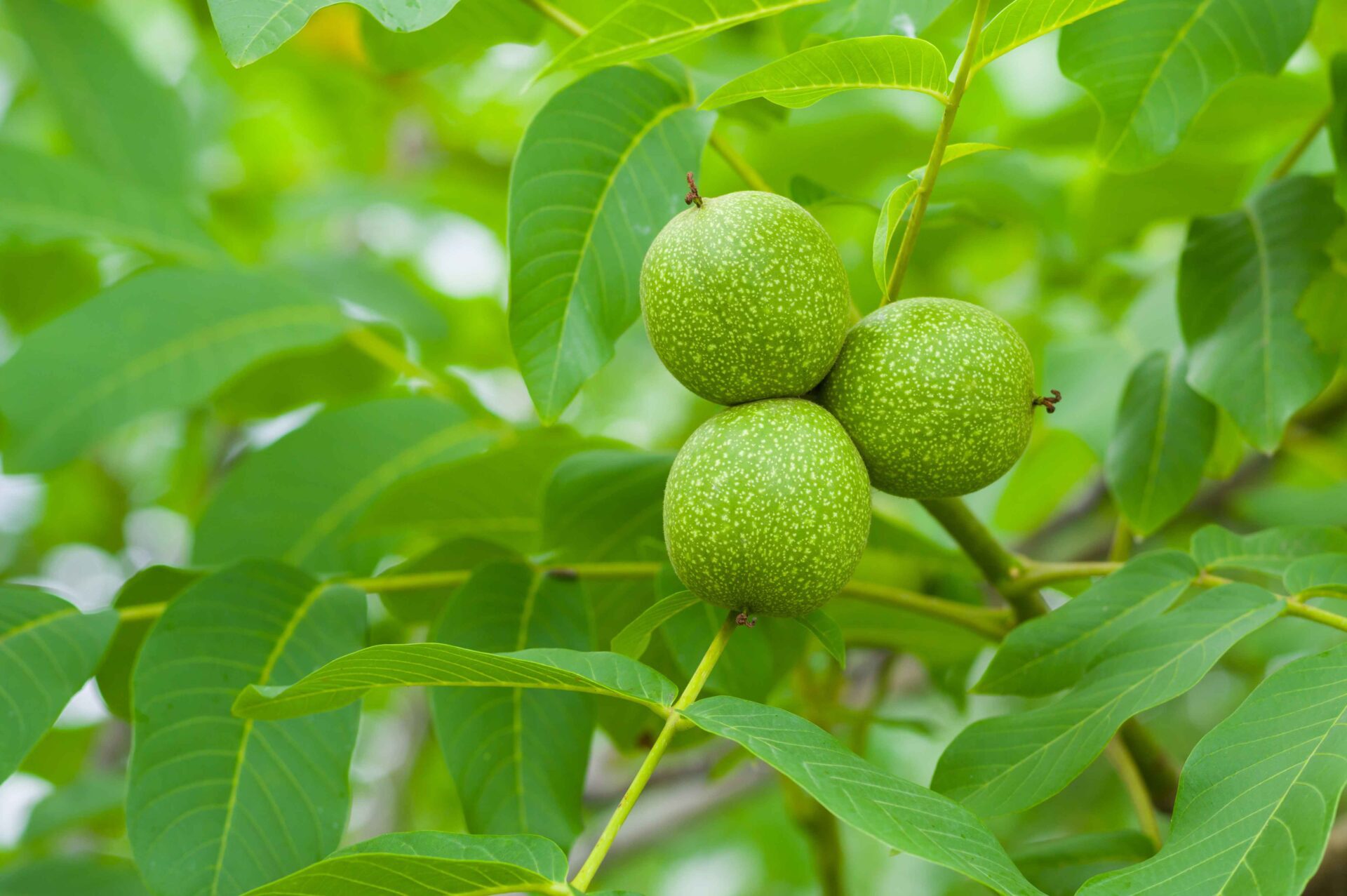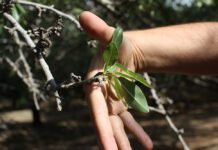Use of the plant growth regulator ethephon can be an important management tool for walnut growers who want to maximize kernel quality and minimize navel orangeworm (NOW) damage.
California walnut growers are also using ethephon to better manage their harvest timing said Dani Lightle, University of California Cooperative Extension (UCCE) orchard systems advisor based in Glenn County.
Ethephon
Ethephon has a long history of usage since its discovery almost 50 years ago and Environmental Protection Agency (EPA) registration in 1973. It is one of the most widely utilized plant growth regulators in the world. Besides use in walnuts to speed up hull split, it is used for ripening pineapples and tomatoes and in hybrid seed production. When taken up by a plant it is converted to ethylene, a gas that is responsible for changes in texture, softening, color, and other processes involved in ripening.
In walnuts, according to the University of California (UC) Integrated Pest Management guidelines, ethephon is used to accelerate hull cracking and separation from the shell. This allows for harvest four to seven days earlier than normal depending on the season and variety. Walnut kernels mature before they drop or are shaken, Lightle said, but hulls may not have started splitting. The time delay from kernel maturity to hull cracking can lead to loss of kernel quality and increases the potential for navel orangeworm damage.
Walnut kernels are mature and have the lightest color and highest quality when the “packing tissue” between the kernel halves turns brown. UC farm advisor Bob Beede in Kings County said that to ensure high quality walnut kernels and prevent NOW damage, harvest should be done as close as possible to the time when most nuts have reached the packing tissue brown (PTB) stage.
Kernels achieve the maximum oil accumulation when the color of the packing tissue surrounding the kernel changes from white to brown. The tissue continues to darken in color as the nut ages. Kernel maturity, Beede said, is achieved 21 or more days ahead of normal harvest. During that time, the green hull begins to break down and separate from the shell. This period of time also sees the walnut kernels continue to darken, and lose value. The risk of NOW damage also increases.
Varietal Differences
Beede said his research in Kings County shows that walnut varieties can differ in their response to ethephon applications.
Serr produces the least amount of ethylene after treatment than Payne, Tulare or Chandler. Tulare produces the most. Lightle said the Howard variety in the north has more of a response to ethephon than Chandler. The response in Tulare in the south has made ethephon applications standard, Beede noted.
Research done by the UC Davis plant sciences department has found the lower ethylene production from treated Serr walnuts is possibly due to lower absorption rates by the hull. This variety has smaller pore spaces that the more responsive Payne variety. Beede said testing is being done with adjuvants to see if they can help with absorption. Organosilicones did not improve ethephon activity, he said.
Timing the Treatment
Timing the treatment is important. Beede said three years of research in Kings county showed that packing tissue brown occurs last in the bottom of the canopy and fully shaded walnut canopies have greater variability than those with full sunlight. He recommends sampling at least two weeks ahead of when PTB is expected. Walking diagonally through the orchard, at least 100 nuts should be collected and cut in half. Only nuts with complete browning of packing tissue should be counted. For a two-shake harvest, ethephon is applied when 95 to 100 percent of the nuts have reached PTB. Depending on weather conditions, harvest can begin 7-10 days earlier than normal, followed by a second shake two weeks later. For a one shake harvest, Ethephon is applied when all sample nuts have reached PTB and about 10-14 days before normal harvest date. Hot weather can delay activity and test shakes are recommended to determine harvest readiness.
Application delayed five to seven days after full PTB will improve percent of nut removal and chances of a single shake harvest. It is better to be late in applying ethephon rather than early, Lightle said. Losses in weight and nut quality can occur from early ethephon applications. Applications delayed more the 14 days will have minimal benefit.
How to use ethephon
This product is registered for use as a foliar spray. It can be applied by air at a higher concentration rate, but there is a risk of defoliation. Ethephon should not be applied to low vigor, diseased or stressed trees. It should be applied at temperatures over 60 degrees F and under 90 degrees F. Outside those ranges it will be less effective. The spray mix should be applied within four hours of mixing.
Beede recommends a ground application with large self-propelled sprayers in the southern walnut growing regions, four to five pints of ethephon mixed with 150-2000 gallons of water per acre with ground speed in the 1.5 to 2 mph range depending on canopy size. The mixture must hit the nut to be effective.
Beede said northern area growers have reported success with aerial applications on responsive varieties Howard, Hartley and Vina. Reported use rates are two to four pints in 40 gallons of water per acre.
Lightle said growers often treat some blocks and leave others to ensure the treated blocks can be harvested at the optimal time. If harvest is earlier than normal growers should also make sure their dryer is ready to process.
Does it pay?
Beede said research shows nut value improved by five cents per pound, mostly due to the lighter kernel color. There is also value in protection from navel orange worm damage and very dark kernel coloring.

Cecilia Parsons
Cecilia Parsons has lived in the Central Valley community of Ducor since 1976, covering agriculture for numerous agricultural publications over the years. She has found and nurtured many wonderful and helpful contacts in the ag community, including the UCCE advisors, allowing for news coverage that focuses on the basics of food production.
She is always on the search for new ag topics that can help growers and processors in the San Joaquin Valley improve their bottom line.
In her free time, Cecilia rides her horse, Holly in ranch versatility shows and raises registered Shetland sheep which she exhibits at county and state fairs during the summer.
















